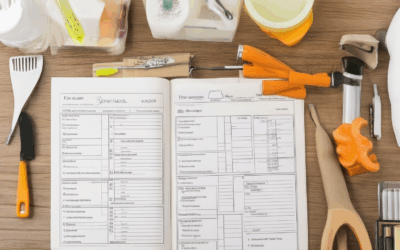As a homeowner, one of the most important tasks you can undertake is preparing your property for the seasons ahead. Whether it’s gearing up for winter, spring, summer, or fall, each season brings its unique challenges that require attention to detail. A well-prepared seasonal home repair checklist can help you stay organized, ensure your property remains in great shape, and prevent minor issues from turning into major problems down the line. From checking gutters to inspecting chimneys, addressing these tasks proactively can save you time, money, and stress in the long run. In this comprehensive guide, we’ll walk you through everything you need to know to keep your home in top condition all year round.
Key Takeaways
– Regular Home Maintenance Prevents Costly Repairs: Schedule annual checks for HVAC systems, plumbing, and electrical components to avoid unexpected issues.
– Gutter and Downspout Cleaning: Twice a year, ensure these areas are clear to prevent water damage and extend roof lifespan.
– Appliance Care: Clean refrigerator coils monthly, descale dishwashers quarterly, and check stove vents annually for optimal performance.
– Exterior Checks: Inspect roofs, walls, and siding annually for damage or wear, and clean gutters to maintain proper drainage.
– Interior Systems: Test smoke detectors, carbon monoxide alarms, and inspect plumbing pipes for leaks or corrosion.
– Landscaping and Yard Maintenance: Trim grass, prune trees, and maintain fencing to keep your property looking great and functional.
– Energy Efficiency: Regular HVAC servicing improves energy efficiency, reducing long-term costs.
– Safety First: Inspect locks, windows, and security systems to ensure your home is protected.
– Seasonal Task Planning: Create a checklist tailored to your home’s needs, focusing on areas like lawn care and attic inspections.

Duties of Home Maintenance
Home maintenance involves a series of routine tasks aimed at preserving the condition and functionality of your living space. Here’s a breakdown of the primary responsibilities:
- Monthly Checks:
- Inspect for leaks in pipes, faucets, and appliances.
- Clean and block drains to prevent clogs.
- Test smoke detectors and carbon monoxide alarms.
- Check for wear and tear in flooring, walls, and windows.
- Quarterly Tasks:
- Service HVAC systems and change filters.
- Inspect and clean gutters and downspouts.
- Test fire extinguishers and ensure they’re functional.
- Examine the exterior for signs of damage or decay.
- Annual Responsibilities:
- Servicing major appliances like refrigerators, ovens, and water heaters.
- Checking the condition of roofing materials and sealing leaks.
- Replacing worn-out caulking and weatherstripping.
- Performing a full inspection of the electrical system.
Effective home maintenance requires a combination of regular inspections , timely repairs, and proactive measures to prevent issues from escalating. By addressing these duties consistently, homeowners can ensure their living spaces remain safe, comfortable, and well-maintained over time.
How to Maintain a Seasonal Home
Regular maintenance is crucial to keep your seasonal home in great shape. Here’s a comprehensive guide to help you:
- Conduct Regular Inspections
- Inspect the property at least once every three months.
- Check for structural issues like cracks, peeling paint, or damaged roofing materials.
- Examine chimneys, pipes, and vents for leaks or blockages.
- Examine the Exterior
- Look for missing or damaged shingles on the roof and replace them if needed.
- Clean and check gutters and downspouts to prevent water buildup.
- Inspect siding for signs of wear and tear, especially on wooden surfaces.
- Test windows and doors for proper sealing and functionality.
- Check decks and patios for rot, warping, or loose boards.
- Assess Water Systems
- Turn on all faucets to check for low water pressure or discolored water.
- Inspect the water heater for rust or leaks.
- Test the septic system, particularly the pump, if applicable.
- Check for frozen pipes, especially in colder climates.
- Evaluate Electrical Systems
- Check for tripped circuit breakers and ensure GFCI outlets are functioning.
- Test lighting fixtures for loose wiring or bulb issues.
- Inspect outdoor electrical outlets for damage or exposed wires.
- Test Appliances and Systems
- Start and run the HVAC system to ensure proper heating and cooling.
- Operate kitchen appliances like refrigerators and stoves to check functionality.
- Test smoke detectors and carbon monoxide alarms.
- Secure the Property
- Ensure locks are secure and windows are closed and locked.
- Check for signs of tampering or forced entry.
- Test security alarms and cameras if installed.
- Monitor the Yard and Garden
- Clear debris and trim bushes, trees, and grass.
- Inspect sprinkler systems for proper coverage and leaks.
- Interior Checks
- Search for signs of pests or rodent activity.
- Look for mold or mildew growth, especially in damp areas.
- Clean and store items in attics and crawl spaces to prevent moisture damage.
- Fire Safety Measures
- Ensure fire extinguishers are present and functional.
- Check smoke detectors for proper placement and functionality.
- Budgeting and Planning
- Create a maintenance schedule to spread costs evenly.
- Plan for replacements of aged components before they fail.
- Hire professionals for complex tasks requiring specialized skills.
- Stay Informed
- Refer to maintenance guides and resources for detailed procedures.
- Familiarize yourself with local building codes and regulations.
- Consider professional inspections to catch potential issues early.

What is Seasonal Maintenance?
Seasonal maintenance refers to a series of tasks and checks performed on homes, vehicles, and other systems to ensure optimal functionality and longevity throughout different parts of the year. These tasks are specifically tailored to address the unique challenges posed by changing seasons, helping to prevent damage, reduce energy costs, and maintain overall property value.
- Spring Maintenance:
- Lawn care: Seed, fertilize, and aerate lawns.
- Gutter cleaning: Remove debris and ensure proper drainage.
- Check HVAC system: Inspect and service air conditioning units to ensure efficiency.
- Summer Maintenance:
- Exterior inspections: Look for peeling paint, missing shingles, or damaged siding.
- Pool maintenance: Clean filters, test water chemistry, and ensure proper circulation.
- Tree trimming: Remove branches that may interfere with power lines or block sunlight.
- Fall Maintenance:
- Yard preparation: Seed lawns, fertilize, and aerate soil before winter.
- Raking leaves: Clear gutters and remove debris to prevent clogs.
- Check furnace and heating systems: Service and inspect for proper operation.
- Winter Maintenance:
- Weatherproofing: Insulate windows, doors, and pipes to prevent freezing.
- Roof inspection: Check for ice dams and clear accumulated snow to prevent damage.
- Vehicle storage: Prepare cars for winter by checking fluids and tires.
Regular seasonal maintenance helps protect your home and family from the effects of extreme weather conditions, ensures energy efficiency, and prolongs the life of your property’s systems and structures. By addressing these tasks promptly, you can avoid costly repairs and enjoy a comfortable living environment year-round.

How Often Should Home Maintenance Tasks Be Performed?
The frequency of home maintenance tasks varies depending on the specific system or area of your home. Here’s a breakdown of recommended schedules to keep your living space in optimal condition:
- HVAC Systems (Heating, Ventilation, Air Conditioning): Inspect and service twice a year, typically in the spring and fall. Clean or replace filters monthly.
- Gutters and Downspouts: Clean outtwice a year, in the spring and fall, to prevent clogs and water damage.
- Plumbing: Check faucets, drains, and pipes every few months for leaks or blockages. Annual inspection of water heaters is also recommended.
- Electrical Systems: Inspect circuit breakers and outlets every six months. Test smoke detectors and carbon monoxide detectors monthly, replacing batteries as needed.
- Roofing: Check for missing shingles or damage annually, especially after severe weather events.
- Landscaping: Trim grass, prune trees, and maintain garden beds seasonally, typically in spring and fall.
- Windows and Doors: Inspect seals and functionality twice a year, ensuring they’re weatherproof and operating properly.
- Appliances: Clean refrigerator coils monthly, descale dishwashers quarterly, and check stove vents annually.
- General Cleaning and Organization: Declutter and clean storage areas quarterly to maintain functionality and safety.
By adhering to these maintenance schedules, you can extend the life of your home and ensure it remains a safe, comfortable, and energy-efficient space. For professional assistance or further details, visit our maintenance services page or explore our home maintenance tips .
What Are Examples of Maintenance Tasks?
Residential Maintenance
- Inspect and clean gutters and downspouts to prevent clogs.
- Lubricate moving parts of appliances like garage doors and lawn mowers.
- Check and replace air filters in HVAC systems.
- Test smoke detectors and carbon monoxide alarms.
- Clean and service chimneys and flues annually.
- Examine windows for cracks and drafts.
- Service water heaters and plumbing fixtures.
- Maintain landscaping, pruning trees, and trimming grass.
Commercial Maintenance
- Inspect and repair roofing systems regularly.
- Perform scheduled equipment inspections for machinery.
- Service and maintain parking lots and roads.
- Monitor and clean ductwork in HVAC systems.
- Inspect and repair electrical systems and wiring.
- Service and test fire suppression systems.
- Maintain and monitor security systems.
- Schedule regular pest control treatments.
Industrial Maintenance
- Inspect and repair large-scale equipment like turbines and generators.
- Service and maintain high-pressure boilers and tanks.
- Inspect and replace worn-out belts and bearings.
- Clean and maintain large-scale piping systems.
- Service and test industrial electrical panels.
- Monitor and maintain cooling towers and refrigeration units.
- Inspect and repair storage tanks and vessels.
- Service and maintain heavy machinery and vehicles.
For professional guidance and tools to perform these maintenance tasks effectively, visit The Home Depot or explore Lowe’s for supplies and resources.

What Maintenance Does a House Need Every Year?
To keep your house in optimal shape, it’s essential to perform routine maintenance tasks annually. Here’s a comprehensive guide to ensure your home stays in great condition:
Exterior Maintenance
- Roof Inspection: Check for missing shingles, leaks, or damage caused by weather.
- Wall Checks: Look for peeling paint, cracks, or signs of rot.
- Gutter Cleaning: Remove debris and ensure they’re free from leaks.
- Siding Inspections: Check for warping, discoloration, or termite damage.
- Driveway and Walkways: Clean and inspect for cracks or uneven surfaces.
- Deck Maintenance: Replace rotten wood, tighten screws, and inspect for structural issues.
Interior Maintenance
- Flooring: Check for loose tiles or boards and inspect grout for cracks.
- Foundation: Look for cracks or gaps around the base of your house.
- Plumbing Pipes: Inspect for leaks or corrosion under sinks and behind fixtures.
- Bathrooms: Check for water damage around showers and bathtubs.
- Kitchen Appliances: Test functionality and look for wear on surfaces and handles.
- Attic and Crawl Space: Inspect for pests, moisture, or sagging beams.
Systems Check-Up
- Heating and Cooling Systems: Schedule professional inspection and cleaning.
- Water Heater: Check pressure relief valve and ensure it’s functioning properly.
- Electrical System: Test GFCI outlets and inspect for tripped breakers.
- Appliances: Regularly service major appliances like refrigerators and dishwashers.
- Fireplace and Chimney: Inspect for blockages and damage.
Safety Checks
- Smoke Detectors: Test and replace batteries as needed.
- Carbon Monoxide Detectors: Ensure they’re working properly.
- Fire Extinguishers: Check expiration dates and functionality.
- Locks and Windows: Inspect for proper closure and secure installation.
- Security Systems: Test alarms and ensure all components are operational.
Lawn Care
- Sprinkler System: Check for leaks and ensure coverage is adequate.
- Lawn Mowing: Keep grass trimmed and remove weeds.
- Tree and Plant Care: Prune trees and shrubs, and check for pests or disease.
- Fencing: Inspect for damage or missing panels and repair as needed.
By addressing these areas annually, you’ll ensure your home remains in excellent condition and minimize costly repairs in the future. Remember to create a checklist tailored to your specific needs and schedule regular inspections to stay proactive!




0 Comments